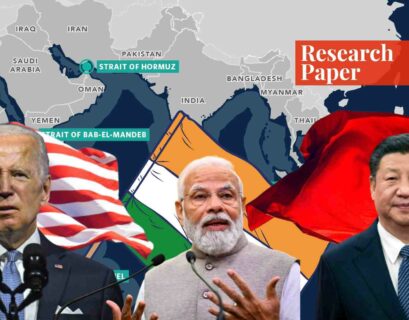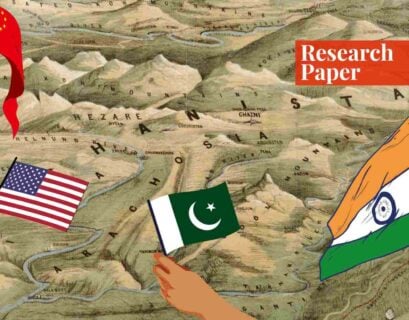Starting in 1991, under the leadership of Manmohan Singh, India embarked on an ambitious program of modernization, liberalization, and globalization. What followed was a decades-long process of economic growth, which put India in a league of its own in the South Asian region. Previously, Pakistan was seen as a credible competitor to India in defence, culture, economy, and international standing, but after India’s sustained economic growth over the past three decades, Indians have stopped identifying Pakistan as their competition.
In any case, India has grown at a phenomenal economic growth rate, averaging on more than 6% over the period under consideration. For example, in 2022, India’s economic growth rate was 7%, and in 2021, it was 9.05%, according to the World Bank. India’s robust economic growth has enabled it to spend heavily on developing its defence and commercial industry under the ‘Made in India’ policy.
‘Made in India’ is another one of the same policies where countries have tried to indigenize the production processes so that they may be able to produce and export to the outside world. Over the last forty years, China has successfully embarked on such a program of indigenization, where it has successfully taken over the role of the ‘workshop of the world.’ It is virtually producing everything with minimal costs and supplying its produce to all parts of the world, making good use of the WTO charter.
Following in the same lane, India has also started to push for indigenization, inviting global giants like Apple to shift their production houses to India. However, India’s push for indigenization is broader than commercial production. India is actively seeking to indigenize the production of defence equipment to become a net supplier of cutting-edge solutions in defence like the United States. However, India’s efforts at indigenizing the defence sector have faced many obstacles.
Writing for the Brookings Institution, Stephen P. Cohen and Sunil Dasgupta argued in 2010 that the drag on India’s military indigenization and growth is caused by too much control practiced by the civilian government over military institutions. They argued that the thinking of the political leadership of India concerning defence and its policy toward Pakistan has been characterized by ‘strategic restraint.’ They have always tried to assert too much control over military matters instead of focusing on how to ‘build and field an effective force.’
In recent weeks, news has also emerged questioning the Akash Missile program of India. According to some media outlets, Akash, a surface-to-air missile with a projected range of 30km, was slated to become a hallmark of indigenous defence production. Work on the Akash missile program started back in the ’90s. In 2017, the Modi government, in collaboration with the extensive media network of India, promoted the development of the Akash missile as a success of the ‘Made in India’ policy.
However, after more than five years, the Akash missile program is still struggling to deliver results. There is news that the Akash missile development program suffers from problems in its radar system, electronic control units, and sensors. Also, during live fire tests, 43% of the missiles failed to fire, showing many technical problems in the launch systems of the missiles. In 2015, news also emerged that Tejas Light Combat Aircraft (LCA) had also yet to be developed in the way that it was initially conceived.
At that time, the Comptroller and Auditor General of India (CAG) pointed to a total of 57 shortcomings in the systems of Tejas Mark-1 and declared it unfit for service. Due to improper development of Tejas Mark-1, the Indian Airforce had to go for the upgradation of its MiG-Bis, MiG-29, Jaguars, and Mirage aircraft at a total cost of INR 20,037 crores. Tejas Mark 1 only entered active service in 2016. The problem with Tejas Mark 1 is that it has yet to be tested in a conventional battle, so there is no surety of depending on it in times of active hostilities.
Similarly, it was also reported recently that the Indian Air Force will receive its first Tejas Mark-1A aircraft in the first half of 2024. The development of Tejas Mk-1A has also been riddled with hiccups. There was often a flaw in the design, and sometimes, the serviceability of parts could have been more optimal. In any case, Tejas Mk-1A will be delivered initially in the trainers’ variant and afterward for active combat.
Tejas Mk-1 and Mk-2 can be the jets of tomorrow only if they are operational like the JF-17, irrespective of its 4th generation. JF-17 has been operating for a while, and there is no question regarding its operational credibility and effectiveness. The Balakot incident is living proof of it when, in 2019, Pakistan’s Air Force pilots shot down the MiG-21 of India with their JF-17 Thunder. However, Tejas’ credibility of being swift in active combat is yet to be seen once it has been delivered and is functional.
Adopting Modi’s ‘Atmanirbhar Bharat’ (Self-sufficient India), the Indian Air Force (IAF) navigates the route toward acquiring indigenous military equipment. This change represents a divergence from the reliance on cutting-edge foreign equipment to match enemies’ capabilities. However, IAF’s inability to deliver these fighter types raises serious concerns about these indigenously developed fighter jets’ maturity and need to be operational.
Overall, India has made steady progress in its plan of indigenization. Whether it is military technology or commercial enterprise, India is continually pushing ahead to replace other production centers of the world. In the process, it is generating economic growth, creating jobs and slowly ending its reliance on outside suppliers for strategic technologies.
Over a sufficiently long-term horizon, India will become self-dependent while Pakistan will still be facing its never-ending problems of inefficiency, lawlessness, and state failures. It is, therefore, imperative for Pakistan to set its priorities right and realize that it is being left behind in the race for post-modern development.
If you want to submit your articles, research papers, and book reviews, please check the Submissions page.
The views and opinions expressed in this article/paper are the author’s own and do not necessarily reflect the editorial position of Paradigm Shift.




















